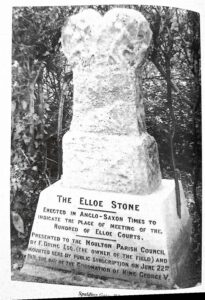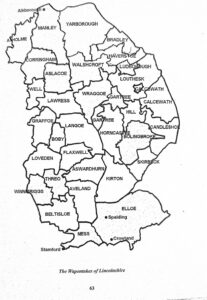Position: One mile north-east of Moulton
Map Ref: TF 313/247
Access: Down Spalding Gate, off the north side of the A151. The stone is situated at the edge of a field.
The inscription reads: “Erected in Anglo-Saxon times to indicate the Meeting of the Hundred of Elloe Courts. Presented to the Moulton Parish Council by F. Dring Esq. (Landowner) and mounted here by public subscription on June 22nd, 1911, the day of the Coronation of George V”.
It is believed that the Wapentake of Elloe was the largest in the county. Whether folk meetings were held on this site is uncertain. Life had to be adjusted to changing circumstances e.g. floodwaters. Part of this area was flooded by high tides, drowning hundreds of sheep in December, 1765.

The Elloe Stone marked the site of our forefathers’ assembled where the men of the Elloe Wapentake held their Hundred Court. The very name of ‘Moulton’ tells us that the ‘Mooť court was held there. Local justice was administered here and disputes settled, while the stone gave its name to a wood nearby (‘Elhostone Wood’) which was destroyed in the nineteenth century.
The stone stood originally on the waste land beside the highway part of the old Roman road from Spalding which rejoined the old turnpike road at Fleet Hargate. In the eighteenth and nineteenth
centuries, the road was encroached on and the stone found itself in the middle of a garden, cultivated until about 1850 by a man called Poppleton. The garden was then absorbed into a field and the stone put in a hedge where it was in 1889, practically invisible. In 1911, it was mounted on a pedestal though later it fell into neglect and had to be remounted, with the inscription below
THE ELLOE STONE
ERECTED IN ANGLO-SAXON TIMES TO INDICATE THE PLACE OF MEETING OF THE HUNDRED OF ELLOE COURTS.
PRESENTED TO THE MOULTON PARISH COUNCIL BY F. DRING, ESQ., (THE OWNER OF THE FIELD) AND MOUNTED HERE BY PUBLIC SUBSCRIPTION ON JUNE 22ND. 1911 THE DAY OF THE
CORONATION OF KING GEORGE V.

Apart from this stone, there is little evidence of pre-Norman times, other than place names, banks and. dykes.
Source: Historic Spalding
Nancy Snowdon adds
On the road almost in the hedge, stands a strange monument, It is quite unique and goes back to Angio Saxon/Danish times. It was formerly in a field but people with good intentions took it, modernized it and placed it on the roadside. Villagers will tell you that it was a stone to sharpen their swords on (which is unlikely) It is known as tell the Elloe Stone. It was probably a boundary stone between two Wapentakes a place of meeting of Elloe Wapentake and its neighbour. It is in fact a marker. It indicates the site of the meeting place of the Wapentake, probably at the border of two or three counties, In an unfenced county, it was an important way for people coming to the meetings to find the place where the Wapentake met. The upper bit of the monurment. a wheel cross is probably 10th century, very weathered, stuck on a block recording its “re erection in 1911”. Perhaps the stone itself was left in the field. It’s all a bit odd. that a Danish word Wapentake’ (only used in Lincolnshire) should become a prop for bicycles when the villagers went blackberrying.
A Wapentake is also what other counties call a hundred; the use of the word is limited to counties where the Danish people predominated, Northern and Midland counties – mainly Lincolnshire. Its origin is old English from the Norse, the word meaning ‘weapons’. Perhaps they voted by show of weapons, waving them, just as we would put our hands up to affirm a proposition. As to the names, they usually refer to some local feature, a wood, a tree, a pond, or a mound. Formerly the measurements used to be hides but Wapentakes came from the Danish who took over everything in the Dane law. Wapentakes were not unchangeable and pieces were lopped off and others stuck in. They probably date back to about King Alfred. They were units for local government for taxation purpose, they indicate how very Scandinavian this part of Lincolnshire was. Many Danish words survive in the local dialect.



2 Responses
Frank Dring was my grandad I remember the Elloe Stone being cleaned up in 1992 in our farm yard
Hi Rosie
Thanks, can you tell us anymore about the stones folklore
Regards
Geoff